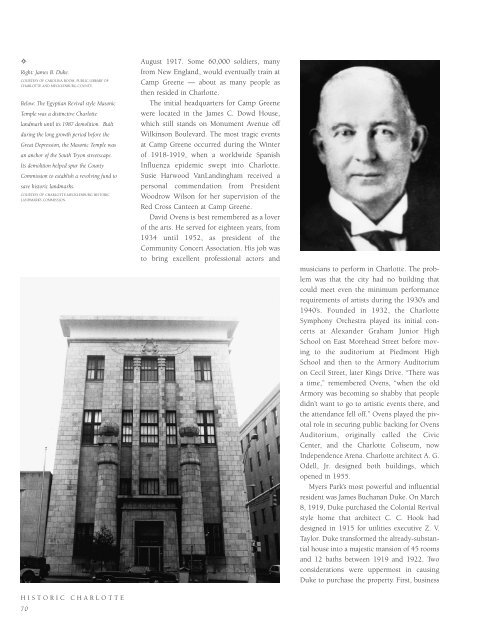Historic Charlotte
An illustrated history of the City of Charlotte and the Mecklenburg County area, paired with the histories of companies, families and organizations that make the region great.
An illustrated history of the City of Charlotte and the Mecklenburg County area, paired with the histories of companies, families and organizations that make the region great.
Create successful ePaper yourself
Turn your PDF publications into a flip-book with our unique Google optimized e-Paper software.
✧<br />
Right: James B. Duke.<br />
COURTESY OF CAROLINA ROOM, PUBLIC LIBRARY OF<br />
CHARLOTTE AND MECKLENBURG COUNTY.<br />
Below: The Egyptian Revival style Masonic<br />
Temple was a distinctive <strong>Charlotte</strong><br />
landmark until its 1987 demolition. Built<br />
during the long growth period before the<br />
Great Depression, the Masonic Temple was<br />
an anchor of the South Tryon streetscape.<br />
Its demolition helped spur the County<br />
Commission to establish a revolving fund to<br />
save historic landmarks.<br />
COURTESY OF CHARLOTTE-MECKLENBURG HISTORIC<br />
LANDMARKS COMMISSION.<br />
HISTORIC CHARLOTTE<br />
70<br />
August 1917. Some 60,000 soldiers, many<br />
from New England, would eventually train at<br />
Camp Greene — about as many people as<br />
then resided in <strong>Charlotte</strong>.<br />
The initial headquarters for Camp Greene<br />
were located in the James C. Dowd House,<br />
which still stands on Monument Avenue off<br />
Wilkinson Boulevard. The most tragic events<br />
at Camp Greene occurred during the Winter<br />
of 1918-1919, when a worldwide Spanish<br />
Influenza epidemic swept into <strong>Charlotte</strong>.<br />
Susie Harwood VanLandingham received a<br />
personal commendation from President<br />
Woodrow Wilson for her supervision of the<br />
Red Cross Canteen at Camp Greene.<br />
David Ovens is best remembered as a lover<br />
of the arts. He served for eighteen years, from<br />
1934 until 1952, as president of the<br />
Community Concert Association. His job was<br />
to bring excellent professional actors and<br />
musicians to perform in <strong>Charlotte</strong>. The problem<br />
was that the city had no building that<br />
could meet even the minimum performance<br />
requirements of artists during the 1930’s and<br />
1940’s. Founded in 1932, the <strong>Charlotte</strong><br />
Symphony Orchestra played its initial concerts<br />
at Alexander Graham Junior High<br />
School on East Morehead Street before moving<br />
to the auditorium at Piedmont High<br />
School and then to the Armory Auditorium<br />
on Cecil Street, later Kings Drive. “There was<br />
a time,” remembered Ovens, “when the old<br />
Armory was becoming so shabby that people<br />
didn’t want to go to artistic events there, and<br />
the attendance fell off.” Ovens played the pivotal<br />
role in securing public backing for Ovens<br />
Auditorium, originally called the Civic<br />
Center, and the <strong>Charlotte</strong> Coliseum, now<br />
Independence Arena. <strong>Charlotte</strong> architect A. G.<br />
Odell, Jr. designed both buildings, which<br />
opened in 1955.<br />
Myers Park’s most powerful and influential<br />
resident was James Buchanan Duke. On March<br />
8, 1919, Duke purchased the Colonial Revival<br />
style home that architect C. C. Hook had<br />
designed in 1915 for utilities executive Z. V.<br />
Taylor. Duke transformed the already-substantial<br />
house into a majestic mansion of 45 rooms<br />
and 12 baths between 1919 and 1922. Two<br />
considerations were uppermost in causing<br />
Duke to purchase the property. First, business
















